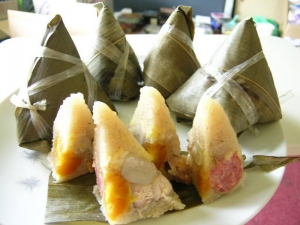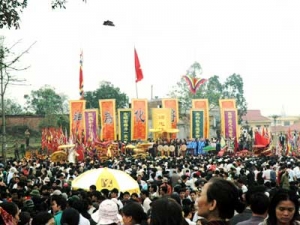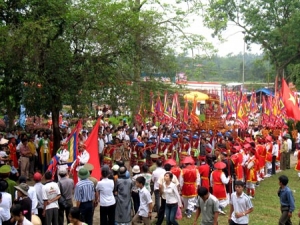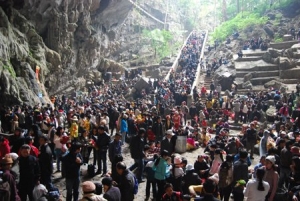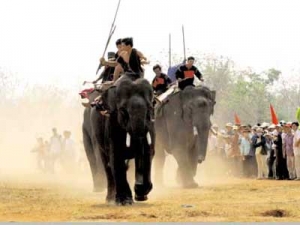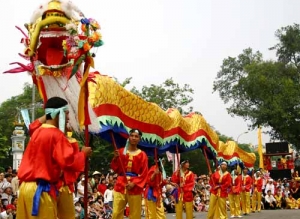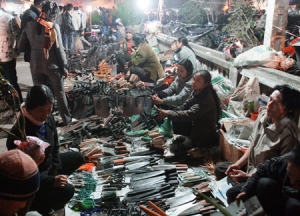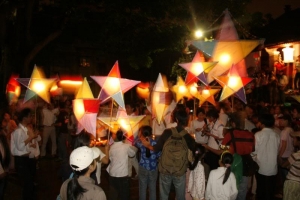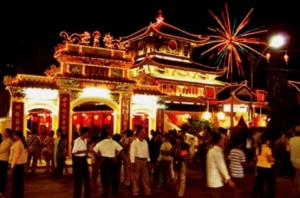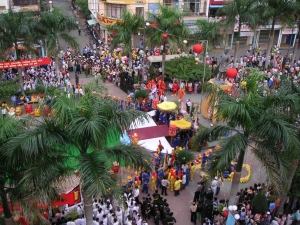
Asia Pacific Travel Team
Doan Ngo Festival (Tết Đoan Ngọ)
"Doan Ngo Festival”, also called “Tết giết sâu bọ” (translated as Festival for “Killing the persons’ inner insects”), is the second most significant festival (to the Lunar New Year Tet Holiday) of Vietnam.
What does these names mean?
Literally,Tet refers to festival, Doan means the start, Ngo is the seventh animalof the Chinese zodiac- the horse. Doan Ngo festival is also known asTết sâu bọ (sâu bọ = worms, pests) or Tết tháng 5, to be celebrated onthe 5th day of the 5th lunar month.
The name “Tet sau bo” derivesfrom the fact that farmers, on this day, get rid of all pests to startgrowing their crops for the new season. Therefore, creatures and peoplemust become stronger in both their health and their souls to overcomethis. On this occasion, the whole family have to get up early and eatfermented sticky and fruits. The worshipping is held at noon, hour ofNgo. The tradition of eating dumplings, especially lye water dumplings,extends from the belief that the dumplings will cleanse one’s body ofany unwanted “parasites”.
Two irreplaceable dishes
The two traditional types of food to be eaten on this holiday are banh u and com ruou. Banh uis pyramidal sticky rice cakes wrapped in banana leaves. They are oftenstuffed with beans and banana leaves’ essence, creating its dominantflavor.
Com ruou,which literally translates as “rice wine,” are little balls offermented rice bathed in wine. Com ruou is associated with the mythtelling that a long time ago, there were two orphan brothers livingtogether in a small village. They were popular among the locals fortheir intelligence and kindness. Also, in that village, there were two snakes Thanh Xa and Bach Xa, which after long lives, turned into spirits. Falling in love with the brothers, theytransformed themselves into beautiful ladies to lure the men. Theirdesire soon became true, Thanh Xa got married the older brother and Bach Xa the younger.
They lived happily together until the men grew unhealthy each passing day,scared of daylight and lived in festering darkness. The localssuspected the presence of a bad spirit, and one day, luckily, a Taoisthermit passed by the village. After being told the affliction, heconducted some spirit type tests and found out that the men’s house hada case of the evils. Brewing a wine potion, he told the locals to feedit to the men. The brothers must eat the potion’s solids and liquids inthe early morning of the next fifth day of the fifth lunar calendar. As soon as the men tucked into their special breakfast, their wiveswere turned into their real appearance of snakes, before disappearingin a puff of smoke, freeing the brothers. Since that day, people haveeaten “ruou nep” on Killing the Insect Day, in the hope of driving awaybad spirits.
The process of making Com ruouis not quite complicated but time-consuming. In order to have good comruou in Doan Ngo Festival, the famers must harvest the reaped rice froma paddy, dried and pounded carefully to keep the most nutritious partof the rice. At first, the rice is steamed twice for about 30 minutesand left for a while to get cool. After that, It is mixed with yeast,before being left for two or three days to ferment, depending on theweather. Com ruou is eaten early on this day to fight the “worms” inone’s stomach.
Just try it, you will see that Com ruou brings youa strong and quite delicious taste. In the Vietnamese traditionalconcept, com ruou can kill any parasites in the body. Vietnamesepeople, from adults to kids, mostly like eating com ruou, yet, adultsare more inclined to gain its curing effects with a grain of salt.
Upto now, besides the Lunar New Year Holiday, Doan Ngo Festival plays asignificant role in every Vietnamese life for practical and holymeanings. Enjoying the atmosphere of Doan Ngo Festival, you will get toknow more about its value and spirits.
A meaningful pilgrimage to the Lim Festival
“My friend, please stay here, do not return home. When doing so, you make me weep silently. The two flaps of my dress will be soaked with tears...” are the so beautiful words of a popular Quan Ho song named “Goodbye” (or “Gia ban” in Vietnamese), that makes our supposed upcoming pilgrimage to the Lim Festival so meaningful.
Objects of worship: Hieu Trung Hau, inventor of Quan Ho tunes
Time: The 13th day of the first lunar month.
Destination: Lim Town, Tien Du District, Bac Ninh province.
Characteristics: Quan Ho singing and folk games
Should you have interest in Vietnamese culture and festivals, you would ratherf ollow us in this following supposed pilgrimage to the Lim Festival. Itis the done thing in Lim Town, Tien Du District, Bac Ninh Province where thousands of visitors go on a pilgrimage to this festival to beheld at the beginning of Spring. Annually taking place from 13th to15th of the first lunar month, the Lim Festival is among the most impressive festivals, ceremonies and singing in Former Kinh Bac, which now account for a majority of villages in Bac Ninh Province.
The distinguished features
The most typical Lim Festival feature is Quan Ho singing, a special folksong, which includes betel offering, hailing ferry and others.Stretching back over 500 years and recently recognised by UNESCO as part of humanity’s intangible heritage, Quan ho is a living historical record of the daily life of Vietnamese people. The beautiful lyrics are of profound meanings, and inclineleading up the pagoda on Lim hill, where Lim Pagoda is located. Lim Pagoda - the place worshipping Mr. Hieu Trung Hau, who invented Quan Ho, is very large and airy with a lot of eucalyptus and couch trees.Like other religious festivals, the Lim Festival goes through all the ritual stages, from the procession to the worshipping ceremony, and includes other activities. The atmosphere is filled with the stream ofmusic and poems, which stimulate people’s feelings. Colorful clothes,conical hats, brassieres and handkerchiefs show the vitality of the spring, human and their surroundings.
Which activities take place in the Lim Festival?
Different from song exchanges in other places, the Quan Ho folk song festival is very well-organised. Visitors from everywhere come to

Hat doi' in Quan ho
enjoy the festival and see the performances of "lien anh" (male singers) and"lien chi" (female singers). These singers are normal farmers of the village and others in daily life, but surprisingly turn out to be the nation's most skilled Quan Ho artists on the special occasion of Lim festival. Their singing performances are consisted of different types of songs, and have ranging stages: in the pagodas’ yard, the communal house’ yard, on the hills, even on boats gently rowed along the river, or elsewhere.
The singers are mostly categorized into two groups, which are called brothers and sisters groups. They dress in their best and distinctive style: men wearing long dress and holding umbrellas, and women, elegant four-flapped dresses with colourful belts, which is their discreet manner, and traditional large flat hats.They have a unique way of approaching one another in the form of songs.
At the beginning of the performance, crowds gather around the singers, andare eager to follow the deft catchy melodies, and savor the humorous,yet often heartfelt lyrics. When each group performs, the audiences listen attentively, while indulging in the traditional chewy festivalfood of An Trau- areca, lime, rose-petal and betel once used to colourteeth and wear away daily troubles. Quan ho is typified by alternateverses sung by different singers, either in pairs or in groups. The twomost popular types of Quan ho are hat doi’ (call-and-response singing)and hat doi (duet singing) groups, which originate hundreds of yearsago, with some of the earliest songs dating back as far as thefifteenth century. According to some scholars, they even began underthe Ly dynasty (1009-1225), when men and women from neighbouredvillages in Bac Ninh province began to sing alternate verses to eachother.

Betel making
Interms of content, the Quan Ho song exchange is multifaceted, involvinganalogies, questions and replies and quizzes on a myriad of subjects.One of the characteristics of Quan ho that remains throughout the timeis the proper verbal and poetic introduction to every tune. Quan hosingers are not only appreciated for their singing ability, but alsofor their skill in leaving an impression of their gracefulness andliterary adeptness on the audience. As a rule, all messages must be insongs with occasionally some explanations to further elucidate theideas. During lunch, the host singers must provide company to theirpartners, offer them food and, again, songs. In the afternoon, thevisiting singers are requested to continue the song exchange up tomidnight when there would be recess and a tea party. Thereafter, thesong exchange goes on until dawn, when guests and hosts and hostesses,again in the form of songs, bid farewell and express keen hope to meetagain some time in the future.
In addition to Quan Ho folksong performances, village festivals also involves many othertraditional games and entertainments, contests, fairs and culturalactivities, such as human chess, water puppetry, lion dances, swinging,wrestling, cock-fighting and more. It is also a traditional opportunityfor young men and women to seek life partners. Young men and women whowant to find their partners often come up hill to sing. There men holdumbrellas while women are wearing flat palm hats, without concern aboutthe sun or rain. Sometimes they can even sing all night to show theirlove, ebullient passion and grace. Besides, visitors can come to theLim Festival to enjoy the weaving competition of the Noi Due girls.They weave and sing Quan Ho songs at the same time.
Beinga special cultural activity in the North, with the Quan Ho folk songperformances and variety of activities, the Lim Festival really impressvisitors. The Festival has become a part of the national culture and atypical folk song festival that is well-loved not only in Bac Ninh Province, but in the Red River Delta region as well.
Hung King Temple Festival
Every year, a large number of visitors from all over the country participate a national festival - Hung King Temple Festival - an incense offering ceremony in honor of Hung Kings, who were instrumental in the founding of the nation. Legend associated with the Hung Kings
It is said that thousands of years ago,Lac Long Quan (King Dragon of theLand of Lac) had superhuman strength and liked to stay near water. He succeeded to the throne of his father, and governed the Lac-Viet tribe.De Lai, king of a northern tribe, with his daughter Au Co made a tripto visit the south.
Admiring Lac Long Quan's talent, De Lai married AuCo to Lac Long Quan. Au Co became pregnant and gave birth to amembranous sac. The sac kept getting larger and larger, and burst onthe seventh day. Surprisingly, there were one hundred eggs in the sac,which hatched into one hundred beautiful babies. The children of Lac Long Quan and Au Co were the ancestors of Vietnam, and so theVietnamese are known as "Dragon and Fairy descendants." The eldest sonof Lac Long Quan and Au Co, who was with this mother, establishedhimself at Phong Chau, now the southern part of Phu Tho Province, andmade himself king. That was King Hung I whose realm was made up by 50tribes. The 18 Hung kings then ruled the country from 2879 to 258BC.
Accordingto historical records, the regime of the Hung Kings was an impressive,brilliant and outstanding start for establishing Viet Nam as asovereign nation. The 18 generations of the Hung Kings saw the birthand development of a nation and are credited with forging nationalcharacteristics such as the sense of community, mutual affection,patriotism and unwillingness to yield to oppression. From this originalsettlement, the Hong (Red) River civilization and the pre-Dong Soncultures grew. From generations to generations, the Vietnamese peoplehold a festival nationwide on the 10th day of the third lunar month tocommemorate the anniversary of their ancestor's death, founder of theVietnamese nation - the first Hung King.
Hung King Anniversary
The Hung King Temple Festival is annually held from 8th to the 11th days of the third lunar month. The main festival day is on the 10th day of the third lunar March, on which theNational Assembly has approved Vietnamese working people to annually have one more national holiday to mark the anniversary of the HungKing’s death.Every year, on this traditional occasion, Vietnamese people worldwide join their brothers and sistersin spirit to observe Vietnam National Day in commemoration of their ancestors. The main ceremony takes place at the Hung Temple on NghiaLinh Mountain in Phong Chau District, Phu Tho Province, some 85kmnorthwest of Hanoi. The Hung King Temple Festival is one of the mostimportant and sacred festivals of the Vietnamese people, deeplyimbedded in the minds of every Vietnamese citizen, regardless of wherethey originated from.
Let’s contemplate this historical vestige!
The Hung Temple is an ancient and sacred architectural ensemble on the top of the 175 metre-high Nghia Linh mountain. The festival offers an opportunity for Vietnamese to visit their land oforigin. A day before the festival, ancient and modern flags are to behung along the road leading from Viet Tri to Hung mountain. A largeballon will also publicise the festival to surrounding areas. On theeve of the festival, 100 flying lights are released into the night sky.The main worship service is held in earnest the following morning, 10thday, beginning with a flower ceremony. In Den Thuong (Upper Temple)where the Hung Kings used to worship deities with full rituals, theceremony consists of a lavish five-fruit feast. Banh chung (square cake) and banh giay (circle cake) are also served to remind people ofthe Lang Lieu Legend (the 18th Hung King who invented these cakes), andthe merit of the Hung Kings who taught people to grow rice. Next to thestage procession for deities, there are several marches in theprocession such as the elephant march followed by the procession chair.The procession marches are followed by a Xoan song performance (aclassical type of song) in the Den Thuong, a "Ca Tru" (a kind ofclassical opera) in Den Ha (Lower Temple), and other activities likecross-bow shooting, rice cooking, swinging contests, cock fighting, and dragon dancing.
On the day of the Hung King Temple Festival, the Vietnamese always jubilantly take part in the festival with religious belief deeply imbedded in their minds, that is their love and pride of their ancestral land. The Festival not only attracts visitors from all over the country thanks to its special traditional cultural activities, but it is also a sacred pilgrimage back to the origins of the Vietnamese nation.
Huong Pagoda Festival
The beautiful verse describes scenic spot of Huong Pagoda, designated by UNESCO as a world cultural heritage site, which makes one can’t help having the feeling that is one were lost in a world offairies. Huong Son attracts visitors not only with its wonderful landscape, but also with its sense of philosophy embodied inside its splendid caves, of which Huong Tich and Tuyet Son are the most impressive.
Objects of worship: Phat ba Quan Am -Avalokitesvara (Goddess of Mercy)
Time: The 6th day of the first lunar month
Destination: Huong Son Commune, My Duc District, Hanoi City (Ha Tay Province - older)
Characteristics: Buddhist services, sightseeing
Visitors are bewitched by the beauty of thesecases which look half real and half unreal. That explains the reason why thecold weather cannot keep thousands of pilgrims and tourists away from the Huong Pagoda Festival, the nation’s longest and most elaborateannual festival.
Legendhas it that the festival is held to worship a princess named Dieu Thienwho incarnated Avalokitasvara and attained enlightenment there. As theprincess was born on the 19th day of the second lunar month, that dateis now observed by all Vietnamese Buddhists as a saint day. The shrine in which she practised her religion was discovered in the 15th century by three monks. The pilgrimage to Huong Son dwindled to a trickleduring the war years and the temples and shrines were left vacant..In 1770, Lord Trinh Sam wrote five Chinese characters to describe Huong Tich Cavern: Nam Thien De Nhat Dong (the most beautiful cave in Vietnam). The Huong Pagoda Festival started during the Le-Trinh Dynasty. In 1958, after the restoration of peace in North Vietnam, the Government and President Ho Chi Minh personally gave instructions for the repair of the pagodas and temples and there storation of the festival. Annually, visitors to the festivalto enjoy the beauty of the Huong Son limestone mountains at a time when apricot trees are in bloom and pay tribute to Buddha, specifically to Avalokitasvara, one of Buddha's disciples.
Accordingto the legend, a pilgrimage to Huong Pagoda in the spring will brin ghealth, prosperity, good luck and happiness. And whether you believe inthe story or not, there's no disputing that a trip like this offers aperfect chance to get closer to both nature and Vietnamese tradition.
A meaningful pilgrimage
The festival is a traditional Vietnamese Buddhist celebration, held simultaneously in three locations: Huong Tich, Tuyet Son, and Long Van.The festival is most crowded from the 15th - 20th day of the 2nd month of the lunar calendar as this period marks the the main festival.However, since the first day of the lunar New Year, thousands of tourists and pilgrims have flocked to the sacred land to tour and pray for a prosperous and happy year. Spring is the idea time for both Vietnamese and foreigners come to Huong Son. Heading there, you have chances to live in a boisterous atmosphere of a spring festival amidst beautiful landscape. They seem to be free from all tiredness andsorrow and come to pay respect to the compassionate Buddha.
Unlikemany other festivals, the Huong Pagoda Festival does not centre around traditional games, but rather romantic trips to caves, pagodas and temples and participation in ceremonies to beseech favours from Lord Buddha. The Venerable Thich Minh Hien rang the bell to officially open the festival at the Huong Pagoda, on the sixth day of the first lunar month. The opening ceremony began at the Thien Tru Pagoda with pilgrimsand tourists invited to take part in the incense offering ceremony. In order to warning up the festival’s lively ambience in the chilly weather, the traditional raditional songs and dances took place beforeand after the ceremony. Visitors attending Huong pagoda festival usually make some wishes and when they are worshipping Buddha’s in the pagoda, they pray for their wishes to come true. The visitors bringofferings with them from home, including boiled chickens, boiled pigs'heads and steamed sticky rice. After prayers, each person will take asmall portion of the offering (called loc) which is then carried home for their family. Loc isa sacred and precious thing as it is believed to bring good luck to those who eat it. In addition, cultural activities and sporting contests are also held on the occasion of Huong Pagoda Festival: boatracing, climbing, folk song singing, etc. These festive activities takeplace throughout the festival.
Apilgrimage to the Huong Pagoda Festival cannot only be for religiousreasons, but to see the numerous natural shapes that are typical of thelandscape and the buildings that are valuable artifacts of the nation.When you make a pilgrimage to Huong Pagoda you are in the middle ofnature at its best, with a gorgeous river, caves, andmountains.Therefore, people of different ages all so interested in theHuong Pagoda Festival...
Makes one wonder whether it is fairyland
Huong Son itself is fairyland
Which is seen in this earthly world"
Elephant Race Festival, Dak Lak
If you have a chance to Dak Lak Province in springtime, you should not miss the Elephant Race Festival, normally celebrated in the third lunar month. Attending the festival, you will be lived in the boisterous atmosphere of the echo of gongs and the spectacular performances of the elephants from the Central Highlands forest.
The Elephant Race Festival is usually held in Don Village or in forests near the Sevepoi River. In preparation for the festive day, people take their elephants to places where they can eat their fill. Apart from grass their food also includes bananas, papayas, sugar canes, corns,sweet potatoes. The elephants are free from hard work to preserve their strength. On the big day, elephants from different villages gather at Don Village. The race track is on even ground, preferably wide enough for ten elephants to stand simultaneously in a line with a length of one to two kilometres. People from near and far in their best and colourful costumes flock to the festival.
The winning elephant is given a laurel wreath. Like its owner, the elephant expresses its happiness and enjoy the sugar canes and bananas from the festival-goers. After this race, the elephants participate in the competition of swimming across the Serepok River, of tug-of-wars,or throwing balls and playing football. When the race comes to an end,the competing elephants bring back the atmosphere of the festival to their villages. Upon returning to their village, they receive warm welcome from the villagers. Very often, the elephants from Don Villagew in the prizes as the village has a tradition of training and tending elephants.
The elephant race is the biggest festival in the Central Highlands. Coming here, you will not only feel the martial spirit of the M'nong ethnic people, who are very famous for their bravery and skill in hunting wild elephants, but also the magnificent landscape of the Central Highlands which further stresses the grandiose characters of this traditional festival.
Tran Temple Festival, an atmosphere full of the “Dong A” spirit.
The expression lingered in the mind of the Viet people like a reminder of finding way back to the root as August and March came to join vivid festivals in memory of Father and Holy Mother, who founded and protected the supernatural land. One of such traditional major festivals, serving as a pride of indigenous inhabitants as thinking about the kingly race of the Viet’s nation:Tran Temple Festival.

Pho Minh Tower
Thecluster monuments of Tran Temple is located in the suburb of Nam DinhProvince with many communal houses, pagodas, temples, tombs, stoneshrines. Temples of Thien Truong, Co Trach and Pho Minh Pagoda - thefamous cultural historical relics dedicated to Tran reign, founded onthe land where the regime of Tran was generated. It is Tran Temple. Inwhich, Thien Truong Temple worships 14 Tran Kings, set up under thelater Le Dynasty. Co Trach Temple worships Tran Hung Dao, set up underthe Nguyen Dynasty.
TranTemple Festival annually lasts from the 15th-20th of lunar August. Inthe odd years, the festival is launched more magnificently than in evenyears. Nevertheless, visitors all over the country do not wait for thevery happening of the festival to join but eagerly go on pilgrimage farprior to the day. On their arrival, every people do expect the good andhappy things. The large flag flutters in front of the temple - thetraditional flag with striking colours standing for five basicelements, its square shape stands for earth (negative), thesickle-shaped tassels for heaven (positive). The word “Tran” isembroidered amidst the flag in Chinese characters by two combined words“Dong” and “A”.
And the activities...
TranTemple Festival happens formally, consisting processions fromneighbouring villages to Thuong Temple. The incense-offering riteinvolves in 14 virgins carrying 14 trays of flowers into the temple andplacing them on thrones in the musical vibration. This act is the imageof the former feudal courts.
Thefestival involves various cultural activities: cock fighting,five-generation fighting art performances, wrestling, unicorn dance,bai bong dance, sword dance, cheo singing, van singing and so on.According to historic records, under the rule of King Tran Nhan Tong,after the Mongolian invaders were defeated, the King offered feastthrough 03 successive days known as “Thai binh dien yen”. The Greattutor Tran Quang Khai composed the dance for the victory namely “bai bong” and taught the imperial singers toperform. The dancers were pretty ladies dressed in the ethnic clothes,putting on their shoulders a short pole hanging with flower baskets orpaper-made lanterns at the two ends. The dancers also held on to a fanto enrich their performance. “Bai bong” dance contained acts of “batdat”, “luc dat” and “tu dat”. Nevertheless, it was neatly adjustedunder the Nguyen Dynasty. Currently, there is still a team of skilleddancers of the kind in Phuong Bong ward on the outskirts of Nam Dinh.It is said that Hat Van is derived from Hat Chau composed under theTran Dynasty, popularised and trimmed under the Le Mat time.
Overthe last years, branches and departments, especially theculture-information sector in Nam Dinh, have paid attention topreserving and enhancing such cultural identities. Nam Dinh Provincetakes pride in its reference of “national root”, giving birth andnursing hearts and souls of “Mother” and “Father” of the people. On theoccasion of the festival, people across the country are warmly welcometo the place by the local friendly and simple residents.
Theunique cultural activities, especially the splendid and radiantatmosphere of “Dong A”, make Tran Temple Festival attractive totravellers everywhere...
Vieng Market Festival
Legend has it that Vieng market islinked somehow to the person who brought copper casting to the area, Nguyen Minh Khong, so people who go the market feel that they will get lucky if they buy something made of copper at Vieng market on this day.
Themarket opens on the 8th of lunar January; nevertheless, the mostspiritual moment falls on the night of the 7th and early 8th. That isthe moment of heavenly-earthly, positive-negative exchange. Accordingto the popular belief, at the time, men and Gods could reach togetherand all the prayers could be perceived more clearly. Trade could at thetime take place smoothly. Consequently, there are 40,000-50,000 peoplecoming to the market on the night of 7th let alone. The market on thenight of 7th is called “Cho am phu” (Hades Market). There are about10,000-12,000 people coming to the market on the following 8th. Themarket-goers not only just enjoy the market atmosphere but also bringalong the feeling toward Mother, praying for fortune and favourablenature, rich crops, happy family. They buy and sell just for aspirationat luck in the rest of the year.
Viengmarket is actually typical to an agricultural countryside that is richin natural products, a kind of radiant open-air “fair” produced by thelocal farmers, especially ornamental plants, speciality crops, subtlecraft articles, utensils, bronze and iron-made tools, etc. This springmarket displays handicraft products, antiquities and false antiquities,utensils, tools for agriculture production, and many kinds ofornamental plants. Specialities are barbecued beef and “bánh dày”(sticky rice cake).
Thecheapest things at Vieng would be flowers and trees, which bring boththe buyer and seller happiness and luck. From around 2a.m, deals aredone under the light of candles or flash-lights. Deals are agreedquickly, as people believe, to keep the luck. From 6a.m, local peoplebring farming tools such as hoes and sickles to sell, which relateclosely to their lives. Buyers believe that the tools will bring themhealth and richness. Vieng market also is also a place to relax. Loverswould find themselves or their happy future here.
Aboveall, everyone visiting the market just wish to buy the burnt veal atany cost, which is considered the indispensable gift from the marketand bliss from fair of the Vieng market-goers. Accordingly, althoughthe Vu Ban residents travelled anywhere, they just thought of thefolk-song as a reminder:
"Enjoying the New Year’s day at home on the 1st
Engaging sports festival at communal house on the 2nd
Going to Qua Linh market on the 4th
Then Trinh market on 5th and Goi market on 6th
The following 7th is just for rest
Packing and travelling to Vieng market on 8th
Because it just takes place once a year."
Full-moon Festival in Mekong Delta
The Khmer ethnic people annually celebrated their traditional Ok Om Bok Festival on the full-moon day (15th day) of the middle Winter to shows their gratitude to the Moon Goddess for giving them a bumper harvest and rich aquatic sources.
Ok Om Bok is now a popular festival celebrated not only in Soc Trang but also in other Mekong Delta provinces of Vinh Long, Tra Vinh, Can Tho,Kien Giang and An Giang. In the Khmer belief, the Moon Goddess is theone who cares for the crops, aquatic sources and human life. Alsocalled Festival of Worshipping the Moon, the Ok Om Bok Festival of eachvillage takes place on the yard of a local pagoda, and the wholeprovince’s Ok Om Bok Festival takes place at Ba Om Pond. The festivalis one of the three typical festivals of the Khmer in the circle of oneyear.
Interesting traditional activities...
Ok Om Bok features folk religion originated from Buddhism. The festival opens by a Ngo Boat Race (Um Tuk Ngua in the Khmer language), one of the most attractiveactivities of the Khmers. The race drew hundreds of thousands of Khmerpeople in the region and tourists nationwide. On the noon of the 14thday, on the Long Binh River takes place the exciting Ngo Boat Race inthe echoing sounds of the Five tones of the traditional musical scaleand the resounding encouragement shouts of tens of thousands ofaudiences. The racing teams from different town and districts on theterritory of Tra Vinh Province and neaby provinces bring a noisy andstirring atmosphere for the festival. Ngo Boat Race is both a game anda way to express the strength of consolidation, as well as atraditional ritual to see off the God Water to the ocean after thegrowing season, and a religious ritual of the Khmer to commemorate theSnake God Nagar, who once turned into a lump of wood to help the Buddhacross the river. It is honored as a sacred relic, used only inessential festivals like Ok Om Bok and is kept and preserved carefullyin local pagodas. The boat is about 24 meters long, 1.2 meter wide andis able to hold about 40 people. Sitting in two lines midway along thesides, young Khmer men and women move gently in harmony with the soundsof gongs and waves. As the first boat crosses the finish line, thecrowds on both riverbanks cheer loudly and enthusiastically for theirvictory. Hundreds of people enthusiastically support their favouriteteams and enjoy the race. Attending the festival, you will have achance to watch the jubilant and competitive boat race of the Khmerpeople.
Duringfull-moon the night, Khmer family members gather in front of thecommunal pagoda or their houses and prepare a special feast with greenrice flakes, ripe bananas, fresh peeled coconuts and mangoes to offerto the moon. When the God Moon rises, the offering ceremonybegins with all family members sitting flat on the ground and claspingtheir hands in wait for the moon to rise. An elderly man expressestheir gratitude to the moon and prays for continued good crops and goodhealth. They prayed to the Moon for bumper harvests all the year round,prosperity and happiness. A jubilant atmosphere prevailed over thecelebration sites where large members of people gathered to enjoy folkart performances, including floating flames, flying balloons, and Khmerstage arts of Du Ke and Ro Bam. Then, the village elders will pick uphandfuls of “com dep” to put into the children’s mouths with a wish fortheir strong eating and rapid development (the word Ok om bok literallymeans eating “com dep” by picking up it and put into the mouth). After

theceremony, they continue looking at the moon, while receiving green riceflakes from an elderly man and making their wishes. At the festivenights, tourists and locals walk in groups around the ponds and enjoylocal food and buy souvenirs. All seem to forget tiring daily work anddrift with the melodies and sounds of folk songs, diverse instrumentsand dance of the Khmer.
The night becomes more exciting with ethnic games and traditional fashion shows.Some join a contest of flying lanterns and silently contemplate thecolors. A flying lantern is made with a bamboo frame pasted with paper.A tinder is tied under the frame then fired, which makes the lanternfly high in the air. The flying lantern rises higher and higher in amysterious and romantic breeze as if bringing the hopes and beliefs ofthe Khmer people to the Moon God, who is tucking up the clouds to lookdown at the earth. At Ba Om Pond, the ritual of the flying-lanternrelease has become an exciting contest with the participation of tensof pagodas in the province under the encouragement of tens of thousandsof festival participants.
Theevent also features water-lanterns made from bamboo and paper in theshape of a boat with colorful decorations. People make a line with adrum band ahead, whisper their prayers to God and gently droppaper-boats on the water. The river is indulged in peaceful andfanciful scenery. This is also the traditional time for couples to prayfor their love and destiny. The festival celebrations also includedtraditional Khmer rituals and special performances by art troupes fromother provinces. People also flocked to downtown Soc Trang for shoppingat trade fairs and watching traditional sports and games.
Really interesting and meaningful, Ok Om Bok Festival is the most imposing festival in Mekong Delta. Once taking part in, and you will realize...
Pilgrims flood Ba Chua Xu Temple Festival
A pilgrimage to Ba Chua Xu Temple Festival will help you to experience the local culture. It is a very colorful and attractive festival attended by people from all over Vietnam and is surely a treat for the tourists.

BaChua Xu Temple was built in 1820, at the foot of Sam Mountain, Vinh TeCommune, Chau Doc Town, An Giang Province. Ba Chua Xu Temple isconstructed according to the Chinese character "quoc", has 4 squareroofs, roofed with blue pile-shaped tiles. According to a legend, inthe early 1800s, villagers found a statue of a lady dating to the 6thcentury in the forest. They built a temple in her honour, hoping thatshe would bring them better crops and better lives. This is why themarble statue of Ba Chua Xu, meaning "country lady" is worshipped. Inthe festival, worshippers touch her statue and ask for her protectionand benediction.
Ba Chua Xu Temple Festival is the biggest folk festivity of Southern Vietnam. The festival is held annually from the 23rd to the 27th of the fourth lunar month with the ceremonies as follows:
The statue of Ba Chua Xu washing rite

Duringthe days of the festival, various rituals are performed. On the firstnight, the statue of Ba Chua is bathed in perfumed water and she isalso made to wear fresh robes for the occasion. Then Ba Chua’sdiscarded garments are cut into little bits and handed out among theworshippers. These are considered lucky charms to keep the possessor ingood health and drive away evil spirits.
Tuc Yet rite
Tue Yet Rite commences after the ceremony of washing. During this ritual of the Ba Chua Xu Temple Festival,the worshippers appeal for Ba Chua’s recommendations to the heaven. Agrand parade of dragon dance is presented along with it and is followedby a chanting ritual in Ba Chua’s temple. Lastly the Duc Boi rite isperformed by a man from the village, who sings aloud for the well beingof the country and mankind.
Participantsdressed in smart traditional costumes stand on the two sides and themaster of ceremonies stands in front of the statue of Ba Chua. Theofferings include a white pig, a dish of pig's blood and a little hair,called mao huyet, a tray of sticky rice, a tray of fruits, a tray ofareca and betel, a dish of rice and salt, which are place on a tablebefore the statue.The master of ceremonies and notables burn incense on the altar.

The festival at night
Xay Chau rite
TheXay Chau rite is performed after the Tuc Yet rite. In order to preparefor this rite, people replace the table before the altar with a drum. Themaster of ceremonies holds two drumsticks and says his prayers beforethe altar. After that, he dips a branch of willow into a water bowl onthe left of the altar, and sprinkles water on the floor. When hefinishes the ritual, he put the bowl and the willow branch on thealtar, and beats three salvos of drumbeat to begin the hat boi(classical opera) performance.
Chanh Te rite
TheChanh Te rite takes place at 4 a.m of the 26th with the rituals similarto Tuc Yet rite. On the afternoon of the 27th day, the four tablets arebrought back to Thoai Ngoc Hau Mausoleum, marking the end of thefestival.
Moreover,during the festival days, many traditional cultural activities areorganised, including unicorn dance, dance with dishes and cups. BaChua Xu Temple Festival is rich in the national identity and thesouthern colours. Peace and tranquility, Ba Chua Xu Temple is one of the major religious sites in the Mekong Delta and attracts thousands of travellerswho are flocking to An Giang Province to experience the one weekfestival and ask the famous goddess of wealth for a prosperous life.
Nguyen Trung Truc Temple Festival
From the 18th to the 19th day of the tenth lunar month, Nguyen Trung Truc Temple Festival is annually organized in Long Kien Commune, Cho Moi District, An Giang Province.
The temple is dedicated to Nguyen Trung Truc, the leader of an insurrection who rose up against the French in the South. Amongother exploits, he led the raid that resulted in the burning of theFrench warship Esperance. Despite repeated attempts to capture him,Nguyen Trung Truc continued to fight until 1868, when the French tookhis mother and a number of civilians hostage and threatened to killthem, he did not surrender. Nguyen Trung Truc turned himself in and wasexecuted by the French in the market place of Rach Gia on 27 October1868.
Thefirst temple structure was a simple building with a thatched roof; overthe years it has been enlarged and rebuilt several times. The lastreconstruction took place between 1964 and 1970. In the centre of themain hall is a portrait of Nguyen Trung Truc on an altar.
Inthe festival, the locals organize incense-offering ceremony, recallingsacrifices-offering ceremony, reperformance of the battle of destroyinga French warships on the Nhat Tao River in the 19th century. The festival involves boat rowing, Chinese chess and other fun games.
Since 2003, NguyenTrung Truc Temple Festival has been considered as one of nationalcultual events with many typical entertainment activities. The festivalattracts hundreds of visitors to participate. Beside traditionalceremory, a cultural program is held for the purpose of culturalexchange betweenethnic groups of Kinh - Hoa – Khmer. Moreover, there remains a number of interesting folk games.
Visiting An Giang Provinceon the occasion of Nguyen Trung Truc Temple Festival, you will be ableto explore and understand the cultural beauty in the region...


